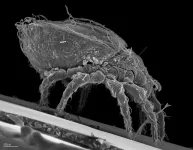(Press-News.org)
Boston – Dana-Farber Cancer Institute researchers have identified factors that determine whether donor lymphocyte infusion (DLI), a standard therapy for patients with acute myeloid leukemia (AML) who have relapsed after allogenic hematopoietic stem cell transplant, will successfully move the patient into remission. The team identified that a key cell type in the DLI product and features of the tumor microenvironment in patients both play a role.
The findings were published in Science Immunology.
“Relapse of AML after stem cell transplant is a major challenge,” says first author Katie Maurer, MD, PhD. “There are few effective therapies, and patient outcomes after relapse are poor.”
For patients with AML, a stem cell transplant holds the potential for a cure. The goal of the transplant is to replace the patient’s hematopoietic stem cells – cells that rejuvenate supplies of blood and immune cells – with donor stem cells that are not cancerous. In addition, the donor cells also include active immune cells that can attack leukemia cells that remain in the patient after the transplant. This phenomenon is called the graft versus leukemia effect.
However, approximately one in three patients with AML relapse after allogenic stem cell transplant. DLI is a follow-on treatment that can help stave off or treat relapse. It involves an infusion of white blood cells, called lymphocytes, from the donor of the stem cell transplant into the patient.
DLI is successful in only about 15-20% of patients with AML. Further, exactly how the cells in the DLI product help move leukemia into remission are not known, making it difficult for investigators to improve the treatment.
Maurer and principal investigator Catherine Wu, MD, chief of Dana-Farber’s Division of Stem Cell Transplantation and Cellular Therapies, wanted to learn more about what factors contribute to the success of DLI. To do this, they examined cells from the bone marrow of 25 patients with relapsed leukemia who had been treated with stem cell transplant and DLI. The sample included patients who responded to DLI and patients who did not.
They employed single cell sequencing techniques to deeply profile multitudes of cells from each patient. This enabled the team to learn not only the range of cell types in the bone marrow, but also how those cells were interacting and driving immune responses in the patient.
The found that patients who responded to DLI therapy had notably different cellular populations in their bone marrow compared to patients who did not respond. The finding suggests that there might be forms of AML that are “hot,” meaning they respond to immune therapy, or “cold,” meaning they do not, similar to the “hot” and “cold” paradigm seen in some solid tumors.
The team also identified a single immune cell type that appears to mediate the graft versus leukemia effect in patients that respond to DLI. The cell type, CD8+ cytotoxic T lymphocytes that express a transcription factor called ZNF683/Hobit at high levels, appear to coordinate with other immune cells to expand and attack leukemia cells. In patients who did not respond, these T cells had lower levels of expression of ZNF683/Hobit and higher levels of markers that inhibit their activity.
Further, the team found that this cell type originates in the DLI product. That is, it is present in the donor’s original graft and re-infused during DLI.
“The goal of our research is to identify the ways in which some patients respond, in the hopes that uncovering these mechanisms can help us create improved therapies that are more effective for a greater number of patients,” says Maurer. “In this project, we identified a specific subset of activated T cells that have anti-leukemic activity. This discovery paves the way for creation of T cell therapies with improved efficacy in treating AML.”
Funding for this research was provided by, The National Institutes of Health, the National Cancer Institute, Columbia University, the American Society of Hematology, the Lubin Family Foundation, the Berlin Institute of Health at Charité, Deutsche Krebshilfe, the Else Kröner-Fresenius-Stiftung, the Cancer Prevention and Research Institute of Texas, the Be the Match Foundation, the Lavine Family Foundation, and the Leukemia and Lymphoma Society.
About Dana-Farber Cancer Institute
Dana-Farber Cancer Institute is one of the world’s leading centers of cancer research and treatment. Dana-Farber’s mission is to reduce the burden of cancer through scientific inquiry, clinical care, education, community engagement, and advocacy. We provide the latest treatments in cancer for adults through Dana-Farber Brigham Cancer Center and for children through Dana-Farber/Boston Children’s Cancer and Blood Disorders Center. Dana-Farber is the only hospital nationwide with a top 5 U.S. News & World Report Best Cancer Hospital ranking in both adult and pediatric care.
As a global leader in oncology, Dana-Farber is dedicated to a unique and equal balance between cancer research and care, translating the results of discovery into new treatments for patients locally and around the world, offering more than 1,100 clinical trials.
END
LOS ANGELES—January 24, 2025—In patients undergoing coronary artery bypass grafting (CABG), a novel analysis evaluating surgeon preference for multi- versus single-arterial grafting may help explain the differing results between prior retrospective analyses and randomized controlled trials regarding long-term survival.
A study presented this week at The Society of Thoracic Surgeons’ 61st Annual Meeting explores findings in more than a million U.S. Medicare beneficiaries who underwent CABG from 2001 to 2019. The researchers found that patients who received multi-arterial grafting (MAG) had improved survival over those who ...
Call it a mystery solved.
North Carolina State University researchers firmly point the finger at the South American Andes Mountains as the place where the Irish potato famine pathogen, Phtytophthora infestans, originated.
In a wide-ranging study of the genetic material found in P. infestans and other members of the Phytophthora species, the NC State researchers provide more evidence that P. infestans spread from South America to North America before wreaking havoc in Ireland in the 1840s. The pathogen still causes late-blight disease on potato and tomato plants around the world.
Much ...
The vestibular system is a network of organs in the inner ears that detects the motions and position of the head. The brain uses this information, along with inputs from the eyes and joints, to maintain the body’s balance.
Visual information has long been proven to affect balance—for example, strobe lights and swirling images can cause instability—but a new study published in PLOS ONE shows that sounds can also be a disruptive factor for those who have vestibular hypofunction, a vestibular system disorder resulting in impaired balance.
“People with vestibular hypofunction have ...
In collaboration with colleagues from international partner institutions, researchers at the University of Cologne have investigated the asexual reproduction of oribatid mites using genome sequencing techniques. They show that the key to evolution without sex in oribatid mites may lie in the independent evolution of their two chromosome copies – a phenomenon known as the ‘Meselson effect’. The research team identified various mechanisms that may contribute to the genetic diversity of the chromosome ...
URBANA, Ill. – Many people struggle to maintain a healthy weight, and choosing the optimal meals for weight loss can be challenging. A research team at the University of Illinois Urbana-Champaign has developed a weight management program that helps individuals plan meals with the assistance of a web application and support from a registered dietitian. In a new study, they discuss the app’s features, development, and implementation.
“The overall goal is to develop an online weight loss program that can be used as prevention as well as treatment in a clinical setting,” said co-author Manabu Nakamura, associate professor in the Department of Food Science ...
In a paper recently published in the leading journal "The Lancet Digital Health", a scientific team led by Stanisa Raspopovic from MedUni Vienna looks at the progress and challenges in the research and development of brain implants. New achievements in the field of this technology are seen as a source of hope for many patients with neurological disorders and have been making headlines recently. As neural implants have an effect not only on a physical but also on a psychological level, researchers ...
About The Study: Sugar-sweetened beverage (SSB) excise taxes were associated with reduced mean body mass index (BMI) among adults in demographic subgroups, including in young adults who consumed the most SSBs, and in Berkeley, in this cohort study. Future research should examine the mechanisms of these associations to inform how SSB taxes could be more equitable for weight-related outcomes.
Corresponding Author: To contact the corresponding author, Emily F. Liu, MPH, email emily.f.liu@kp.org.
To access the embargoed study: Visit our For The Media website at this link https://media.jamanetwork.com/
(doi:10.1001/jamanetworkopen.2024.56170)
Editor’s ...
About The Study: In this cross-sectional study, detained immigrants experienced a high prevalence of poor health, mental illness, and posttraumatic stress disorder (PTSD), with detention periods of 6 months or more associated with higher rates compared with those detained less than 6 months. Duration of custody is one mechanism by which immigration detention might be a catalyst for worsening health.
Corresponding Author: To contact the corresponding author, Altaf Saadi, MD, MSc, ...
About The Study: Older adults hospitalized with sepsis experienced an approximately 50% reduction in long-term nursing home stay or death over a 5-year period before the pandemic in this cross-sectional study. These results suggest that during the pandemic, all individuals, regardless of race and ethnicity, experienced increased long-term nursing home stay or death compared with before the pandemic.
Corresponding Author: To contact the corresponding author, Laurent G. Glance, MD, email laurent_glance@urmc.rochester.edu.
To access the embargoed study: Visit our For The Media website at this link https://media.jamanetwork.com/
(doi:10.1001/jamanetworkopen.2024.56816)
Editor’s ...
Ghent, 24 January 2025 – Our livers contain many different types of immune cells. New research by the team of Prof. Charlotte Scott (VIB-UGent Center for Inflammation Research) and colleagues now reveals that a specific activation state of one of these cell types is required for tissue repair following injury. This suggests these cells may be useful as new therapeutic targets for various liver conditions. The work appears in the journal Immunity.
Liver immune cells
Macrophages are specialized immune cells located in every tissue ...



